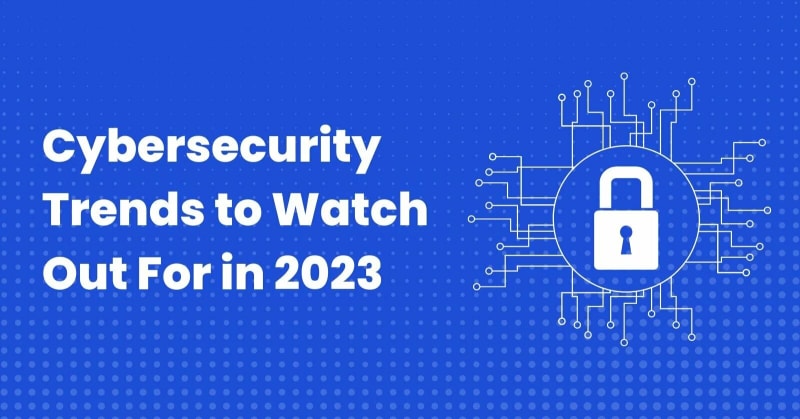As technology continues to evolve and become more prevalent in our daily lives, cybersecurity has become increasingly important. Cyberattacks are becoming more sophisticated and prevalent, making it essential for individuals and organizations to stay ahead of the latest cybersecurity trends. In this article, we will discuss the cybersecurity trends to watch in 2023.
Artificial Intelligence (AI) and Machine Learning (ML)
Artificial intelligence and machine learning are two of the most significant trends in the technology industry, and they are also becoming crucial in the fight against cybercrime. AI and ML can help organizations identify and prevent cyberattacks by analyzing patterns, detecting anomalies, and identifying potential vulnerabilities.
In 2023, we can expect to see more organizations leveraging AI and ML to enhance their cybersecurity strategies. For instance, AI and ML can help detect and respond to cyber threats in real-time, improve threat intelligence, and automate security operations.
Quantum Computing
Quantum computing is another trend that will have a significant impact on cybersecurity in 2023. With quantum computing, hackers can potentially break encryption algorithms, which could lead to significant data breaches.
As a result, organizations need to start preparing for the possibility of quantum computing-powered cyberattacks. This could involve developing new encryption algorithms that can withstand quantum attacks or using other advanced technologies to protect sensitive data.
Cloud Security
Cloud computing has become increasingly popular in recent years, and it is expected to continue to grow in 2023. However, this growth comes with increased cybersecurity risks, as more sensitive data is stored in the cloud.
To address this, organizations need to adopt a comprehensive cloud security strategy that includes monitoring cloud environments, implementing access controls, and ensuring data encryption. Additionally, organizations should be aware of the shared responsibility model for cloud security and ensure they are taking the necessary precautions to protect their data.
Internet of Things (IoT) Security
The internet of things (IoT) is a network of interconnected devices that can communicate with each other and exchange data. While IoT technology offers many benefits, it also presents significant cybersecurity risks.
As the number of connected devices continues to grow, so does the potential attack surface for cybercriminals. In 2023, we can expect to see more emphasis on IoT security, with organizations taking steps to secure their IoT devices and networks. This could involve implementing strong access controls, using encryption, and developing better device management practices.
Identity and Access Management (IAM)
Identity and access management (IAM) is a critical aspect of cybersecurity that involves controlling user access to sensitive data and systems. In 2023, we can expect to see more organizations adopting IAM solutions to strengthen their cybersecurity defenses.
IAM solutions can help organizations manage user identities, authenticate users, and enforce access controls. Additionally, IAM solutions can help organizations detect and respond to suspicious activity, such as unauthorized access attempts or unusual user behavior.
Zero Trust
Zero trust is a security model that assumes that all devices and users are untrusted and requires continuous verification of their identity and access privileges. In a zero-trust model, users and devices must be authenticated and authorized before they are granted access to sensitive data and systems.
Zero trust is becoming increasingly popular as a cybersecurity strategy, and we can expect to see more organizations adopting it in 2023. By implementing a zero-trust model, organizations can reduce the risk of data breaches and improve their overall cybersecurity posture.
DevSecOps
DevSecOps is a security approach that integrates security into the software development process. In a DevSecOps model, security is not an afterthought but is instead built into the development process from the start.
In 2023, we can expect to see more organizations adopting DevSecOps as a way to improve their cybersecurity defenses. By integrating security into the development process, organizations can identify and address security issues early in the development lifecycle, and improve the overall quality of their software.
Cybersecurity Talent Shortage
Despite the growing importance of cybersecurity, there is still a shortage of skilled cybersecurity professionals. This shortage is expected to continue in 2023 and beyond, making it challenging for organizations to find and retain qualified cybersecurity talent.
To address this issue, organizations may need to invest more in training and development programs for existing employees, collaborate with academic institutions to develop cybersecurity talent, or consider outsourcing some of their cybersecurity functions.
Ransomware Attacks
Ransomware attacks have been on the rise in recent years, and they are expected to continue to be a significant threat in 2023. Ransomware is a type of malware that encrypts a victim's data and demands payment in exchange for the decryption key.
To protect against ransomware attacks, organizations should implement strong security measures, such as regular data backups, network segmentation, and endpoint protection. Additionally, organizations should develop an incident response plan to ensure a quick and effective response in the event of a ransomware attack.
Privacy Regulations
Privacy regulations, such as the General Data Protection Regulation (GDPR) and the California Consumer Privacy Act (CCPA), have become increasingly important in recent years. These regulations aim to protect consumers' privacy by setting guidelines for the collection, use, and sharing of personal data.
In 2023, we can expect to see more privacy regulations emerge, as governments around the world seek to protect their citizens' privacy. Organizations should ensure they are compliant with all applicable privacy regulations and take steps to protect their customers' personal data.
Conclusion
Cybersecurity is becoming increasingly important as technology continues to evolve and become more prevalent in our daily lives. Organizations must stay ahead of the latest cybersecurity trends and take proactive measures to protect their data and systems. By adopting advanced technologies such as AI and ML, preparing for quantum computing-powered attacks, and implementing comprehensive cloud security and IoT security strategies, organizations can stay ahead of the cyber threats that may arise in 2023 and beyond.





Top comments (0)